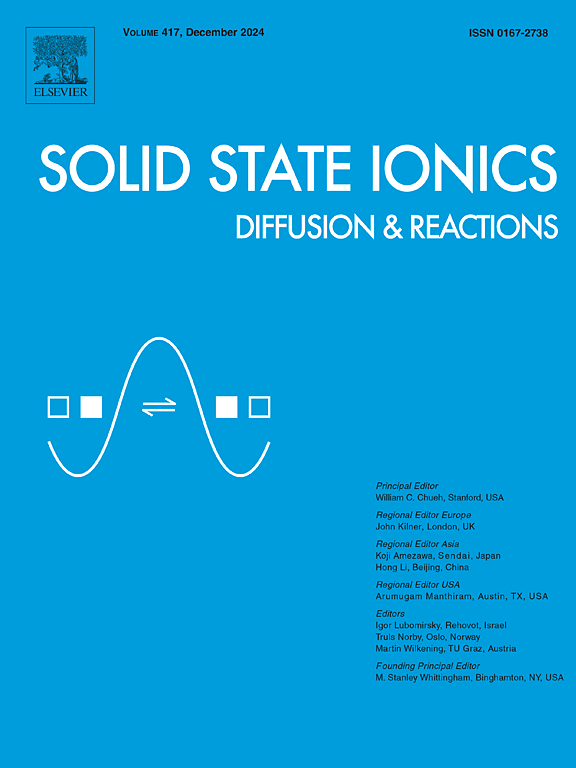Mechanistic insights into oxygen reduction reaction on metal/perovskite catalysts: Interfacial interactions and reaction pathways
IF 3
4区 材料科学
Q3 CHEMISTRY, PHYSICAL
引用次数: 0
Abstract
The oxygen reduction reaction (ORR) is a critical process in energy conversion systems, influencing the efficiency and performance of various devices such as fuel cells, batteries, and electrolyzers. Perovskite-supported metal materials (metal/perovskite) offer several advantages as ORR electrocatalysts, including strong metal-support interactions, oxygen vacancy formation in the perovskite lattice, and synergistic triple-phase boundary (TPB) activity at the interface. Despite their significance, the mechanistic understanding of ORR on metal/perovskite catalysts remains incomplete, particularly at metal/perovskite interfaces. This study investigates ORR on BaZrO3 (BZO) perovskite-supported metal clusters (Pt or Ag) using density functional theory (DFT) to unravel critical insights into charge redistribution at the metal/BZO interface. Energy profiles for elemental steps along two different ORR pathways—oxygen adsorption on the metal cluster surface and direct oxygen adsorption at the TPB—were calculated to explore the effects of different active sites. The results provide a deeper understanding of ORR on metal/perovskite catalysts, emphasizing the role of interfacial interactions and pathway-dependent reaction mechanisms. This work paves the way for guiding the design of high-performance electrocatalysts for ORR in terms of composition, interface design, and local environment modification for a broad range of energy applications.
金属/钙钛矿催化剂上氧还原反应的机理:界面相互作用和反应途径
氧还原反应(ORR)是能量转换系统中的一个关键过程,影响着燃料电池、电池和电解槽等各种设备的效率和性能。钙钛矿负载的金属材料(金属/钙钛矿)作为ORR电催化剂具有许多优点,包括强的金属负载相互作用、钙钛矿晶格中氧空位的形成以及界面处的协同三相边界(TPB)活性。尽管它们具有重要意义,但对金属/钙钛矿催化剂上ORR的机理理解仍然不完整,特别是在金属/钙钛矿界面上。本研究利用密度泛函理论(DFT)研究了BaZrO3 (BZO)钙钛矿支撑的金属团簇(Pt或Ag)上的ORR,揭示了金属/BZO界面电荷再分配的关键见解。计算了两种不同ORR途径(金属团簇表面氧吸附和tpb上氧直接吸附)元素步骤的能量分布,以探索不同活性位点的影响。该研究结果为金属/钙钛矿催化剂的ORR提供了更深入的理解,强调了界面相互作用的作用和途径依赖的反应机制。这项工作为指导高性能ORR电催化剂的设计铺平了道路,包括成分、界面设计和局部环境改造,以实现广泛的能源应用。
本文章由计算机程序翻译,如有差异,请以英文原文为准。
求助全文
约1分钟内获得全文
求助全文
来源期刊

Solid State Ionics
物理-物理:凝聚态物理
CiteScore
6.10
自引率
3.10%
发文量
152
审稿时长
58 days
期刊介绍:
This interdisciplinary journal is devoted to the physics, chemistry and materials science of diffusion, mass transport, and reactivity of solids. The major part of each issue is devoted to articles on:
(i) physics and chemistry of defects in solids;
(ii) reactions in and on solids, e.g. intercalation, corrosion, oxidation, sintering;
(iii) ion transport measurements, mechanisms and theory;
(iv) solid state electrochemistry;
(v) ionically-electronically mixed conducting solids.
Related technological applications are also included, provided their characteristics are interpreted in terms of the basic solid state properties.
Review papers and relevant symposium proceedings are welcome.
 求助内容:
求助内容: 应助结果提醒方式:
应助结果提醒方式:


